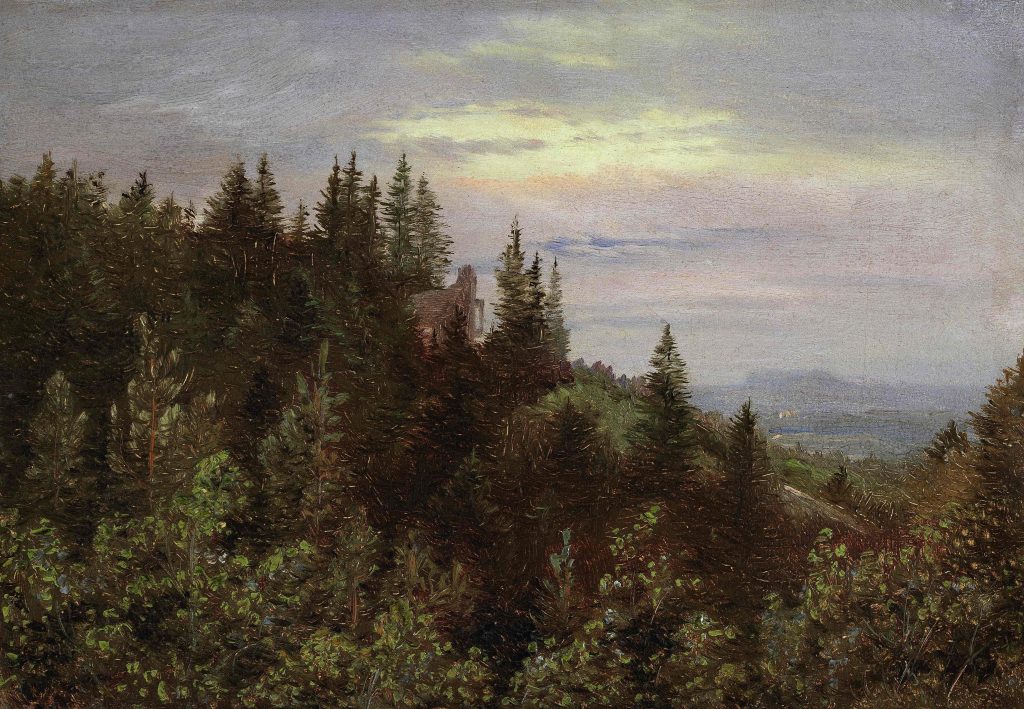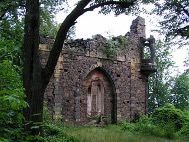Carl Gustav Carus
(Leipzig 1789 - 1869 Dresden)
Evening Light near Pillnitz, c.1835
Oil on cardboard, 13.5 x 19.6 cm
Provenance:
Caroline Cäcilie Carus, the artist’s daughter;
Margarete Schwerdtner, foster daughter of Caroline Cäcilie Carus;
Thence to a god-daughter of Margarete Schwerdtner;
Private collection, New York.
Literature:
Marianne Prause, Carl Gustav Carus. Leben und Werk, Berlin 1968, p.149, no. 287 [as Ruine in Pillnitz über den Weinbergen];
Elisabeth Bülck, C. G. Carus, sein Leben und sein Werk im Verhältnis zu C. D. Friedrich und dessen Schülern betrachtet, unpublished diss., Greifswald 1943.
The painting is accompanied by an expert’s report by Professor Dr. Hans Joachim Neidhardt, former curator at the Galerie Neue Meister in Dresden.
Carl Gustav Carus’s preferred landscape motifs were, from the early 1830s, subjects sketched before nature in the surroundings of Pillnitz, near Dresden. He had purchased a country property near Schloss Pillnitz in 1832 and regularly explored the local countryside. He was personal physician to the Saxon royal family, who spent their summers in Pillnitz, and this obliged him to be close at hand.
The present oil sketch depicts an evening view from the foot of what was known as the Hausberg across the mouth of the Friedrichsgrund valley towards the Pillnitz Schlossberg. Set on the crest of the hill, part-hidden by giant conifers, is an artificial ruin in neo-Gothic style designed by Johann Daniel Schade for Kurfürst Friedrich August III. It was built in 1785 (Fig. 1). In the right background the viewer’s eye is led towards the distant plateau of the Sächsische Schweiz.[1] Professor Neidhardt takes the view that the present work can very probably be identified as no. 287 in Marianne Prause’s catalogue raisonné.[2]
Carus is one of the outstanding figures of the age of Goethe. A man of many talents, he was active as a physician, a natural scientist and a man of letters, as well as being a painter of the first rank. He played a prominent role in the German Romantic movement both as an artist and as an author of important theoretical writings. His Briefe zur Landschaftsmalerei are regarded as of seminal importance in the understanding of the aesthetics of German landscape painting in the Romantic period.[3]
During his medical studies he attended in his free time the Academy of Arts where Friedrich August Tischbein and Hans Veit Schnorr von Carolsfeld were professors. His oeuvre is indebted to the enduring artistic influence of Caspar David Friedrich, a close friend from 1817 onwards. Carus’s work is also indebted to the influence of Johan Christian Dahl who had moved to Dresden in 1818. Carus was to distance himself from Friedrich’s influence in the late 1820s, going on to develop a more personal form of artistic expression. He continued to practise medicine and in 1827 was appointed personal physician to the Saxon royal family. He met Goethe in Marienbad in 1821 and the two men shared a long-standing friendship. Where Carus most clearly reveals himself as an exponent of new artistic trends is in his landscape sketches.[4] His earliest plein-air oil sketches of the countryside around Dresden are dateable to the mid-1820s. He had probably been encouraged to sketch before the motif after seeing the oil sketches of Johan Christian Dahl.
[1] Carl Gustav Carus. Natur und Idee, exhib. cat., Dresden, Staatliche Kunstsammlungen and Berlin, Staatliche Museen, June 2009 - January 2010, Dresden and Berlin 2009, p.206. [2] See Neidhardt’s expert report. [3] Carl Gustav Carus, Zehn Briefe und Aufsätze über Landschaftsmalerei mit zwölf Beilagen und einem Brief von Goethe als Einleitung, 1815-1835, Leipzig and Weimar 1982. [4] Prause, op. cit., p.52f.


